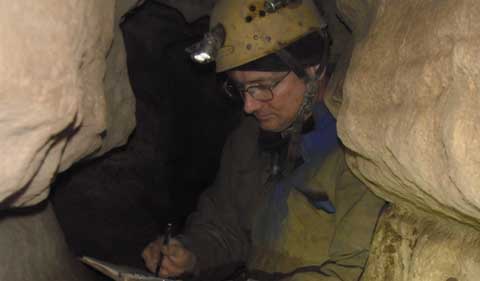Dr. Gregory S . Springer, Associate Professor and Chair of Geological Sciences at Ohio University, co-authored an article on Eastern North American climate in phase with fall insolation throughout the last three glacial-interglacial cycles in Earth and Planetary Science Letters.
His co-authors are Hai Cheng and R. Lawrence Edwards from the University of Minnesota; Ashish Sinha from California State University Dominguez Hills; Benjamin F. Hardt from Massachusetts Institute of Technology; Liang Yi from Tongji University in China; Harold D. Rowe from the University of Texas at Austin; and Hanying Li, Ye Tian, Xianglei Li, Gayatri Kathayat, and Youfeng Ning from the Institute of Global Environmental Change in China.
Abstract: The nature and controls of orbital-scale climate variability in North America (NA) are subjects of ongoing debates. On the basis of previous cave records from Southwestern United States, two mutually incompatible hypotheses have been proposed. One links NA orbital-scale climate variability to Northern Hemisphere (NH) summer insolation forcing in a manner analogous to low-latitude monsoon systems, while the other suggests that it is not causally tied to either changes in global ice-volumes or NH summer insolation. Here we report new cave oxygen isotope (δ18O) records from Buckeye Creek Cave (BCC), West Virginia, east central North America, covering most of the past three glacial-interglacial periods (∼335 to 45 kyr ago). The BCC (δ18O) record exhibits a strong precession-band cycle, which is in-phase with changes in global ice-volumes (i.e., sea level), sea surface temperatures in the NE Gulf of Mexico and is consistent with the results from published cave records from Nevada and Devils Hole. As with global ice-volume, the BCC records lag summer insolation at 65°N by ∼5000 yr, which stands in contrast with records of low-latitude monsoon variability in South America and Asia, which are in phase and out-of-phase with changes in summer insolation and sea level, respectively. Provided the degree of lag to summer insolation provides a measure of competing forcing from global ice-volume and summer insolation, our data suggest that NA orbital-scale climate variability is dominantly driven by ice-volume forcing. In addition, the sea surface temperatures in the NE Gulf of Mexico and changes in northern high-latitude cryosphere may be also important in explaining the unusually low (δ18O) values at times of the intermediate ice-volume periods in BCC and other NA cave records.




















Comments